3 Origins and Early Developments of Culture
Nolan Weil
Suggested Focus
This chapter is full of details. The questions and tasks below will help you pick out the most important ones. Of course, main ideas are important as well. As you pick out details, be sure to ask what it all adds up to.
- Identify two ways in which human culture differs from the culture-like behavior of other animals.
- List all of the tools named in the chapter. Identify the material they were made from and their use. Identify a major innovation in tool making that increased the effectiveness of single tools.
- Make a list of all the objects mentioned in the reading that we moderns might regard as art. Indicate their place of discovery, material, and a notable fact about each item.
- Explain the bold new theory of Michael Witzel. In what way does Witzel’s theory parallel ideas from Chapter 2?
Culture as a product of human activity
Once upon a time, social scientists regarded humans as the only species to exhibit culture. But if language and tool use are both signs of culture, we must acknowledge that other species may also possess some rudiments of culture. Whales and dolphins, for instance, may have some capacity for language. And chimpanzees have been observed making tools, “fishing rods” so to speak, for retrieving termites from their nests. Bottle-nosed dolphins also appear to be tool-users. They have been observed to break off pieces of sea sponge and use them in order to probe for fish along the sea bottom. Ethologists have even observed that some species of songbirds, and some species of fish too, exhibit “socially learned cultural traditions” (Mesoudi, 2011: 195-196).
However, no other species demonstrates the cultural virtuosity of human beings. For one thing, the cultures of non-human species do not seem to show the same tendencies of development and innovation from one generation to the next, as human culture does. For example, the combining of two or more separate elements into entirely new tools or practices does not seem to occur among non-humans, whereas it is a hallmark of human cultural development.
In the last chapter, we placed humanity in a biological context. If the Recent African Origin theory is correct, we said, our earliest ancestors came from Africa and spent 90,000 years migrating to every habitable continent on earth. Along the way, they assumed a variety of different regional appearances. But as they migrated to geographic and climatic regions that sometimes differed from the lands of their ancestors, they met new environmental challenges. New environments required the invention of new tools and new ways of doing things. In turn, the continual development of culturally transmitted knowledge and skill enabled people to become ever more able to thrive in new environments.
In this chapter, we return to our story of human migrations out of Africa and across the globe. This time, however, we will focus on the origins of culture. As you read, keep in mind the seven themes introduced in Chapter 1. In this chapter, we shall frame culture as a product of human activity. But be on the lookout for other themes that may enter the discussion, in particular themes that call attention to functions and processes.
Paleolithic material culture
Our knowledge of pre-historic culture is limited. We can only guess at the beliefs and the daily social interactions of early humans. Our best knowledge of pre-historic life comes from the discoveries of archaeologists who have uncovered many material objects buried or even laying about in old river beds and elsewhere. Sometimes the skeletal remains of early humans are found nearby. Of course, such found objects are limited to those made of materials able to resist the natural forces of decomposition. Among the most plentiful objects are stone tools, the most important of which seem to have served the purpose of securing and processing food. To the casual modern observer, the tools seem rough and unsophisticated. However, careful study of them suggests that their creation required careful planning, detailed knowledge of various materials, and skillful craftsmanship.
To convince yourself that the knowledge and skill of early humans is deserving of admiration and respect, imagine the following situation. You (and a group of friends) are dropped off in a remote wilderness, naked, and with none of the tools or materials you now take for granted. (OK, you may have some matches since it is almost certain you would not know how to start a fire without them.)
All around you is everything you need to survive: rock, wood, edible plants and animals. How will you get food? How about some clothing? You probably will not even know what plants you can eat. You might have some idea what animals you could eat. Suppose you are lucky enough to catch a fish, or a rabbit, perhaps a deer. What will you do with it? With no metal knives, you will have to reinvent stone blades for skinning and cutting up the deer. Stone blades will also be your best bet for scraping the deerskin to make leather for clothing. Good luck (unless you already know something about both stone tools and leather making).
Of course, the exercise imagined above is clearly unfair. If you had been born in the Upper Paleolithic (say 40,000 years ago), you would have been born into a group of people who already had all the necessary tools for hunting, skinning, butchering, and everything else necessary for survival. You would have grown up under the watchful eye of people who knew how to make and use the tools. You probably would have learned by watching and doing, and those more skillful than you would have guided you (Barham, 2013).
When our ancestors left Africa 90,000 years ago, they already possessed technologies for exploiting the environment. At that time, our people, Homo sapiens, were not the only cultural species in the world. Our close cousins, Homo erectus and Homo neanderthalensis were still around, and there is evidence that both of them knew how to control fire. They were makers and users of tools as well. Even the much earlier Homo habilis may have been a toolmaker. Maybe even Australopithecus. Many of the tools that Homo sapiens used had already been in use for over 2 million years. In other words, our ancestors came from a long line of hominid species that survived by means of cultural know-how. So our ancestors ventured forth out of Africa with the best (Stone Age) technology of the day. Encountering new environments and new needs, they refined those tools and developed new ones too (Brown, 1990).
Archaeologists refer to the time between 50,000 and 10,000 years ago as the Upper Paleolithic. It was a remarkably creative period of human cultural development (Feder & Park, 2007). Let’s have a look now at some of the material culture typical of the Upper Paleolithic.
Stone tools
Stone tools were among the most important early tools. Items like the ones shown below enabled early humans to secure protein rich diets. Hammerstones and hand axes were the oldest stone tools in the ancient 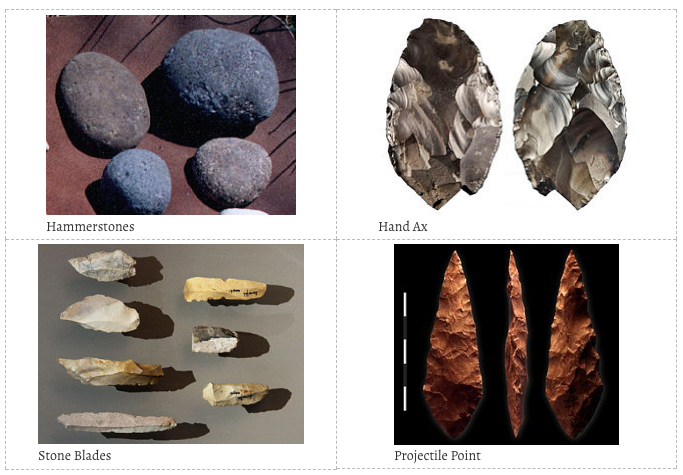 human “toolkit.”
human “toolkit.”
Hammerstones were used for smashing animal bones to get the nutritious marrow inside (“Stone Tool Technology,” 2015). Hammerstones were also used to manufacture sharp stone tools such as hand axes, and a wide variety of other stone blades and projectile points. Toolmakers used a technique known as knapping. By striking a hard sedimentary rock, such as flint, a toolmaker fractured the stone to create a sharp edge. By carefully chipping the edges of the entire rock, the knapper created large hand axes and various smaller blades of stone. Hand axes and blades were used for jobs like cutting meat, scrapping animal skins to make leather for clothing, and for carving or whittling wood (“Stone Age Tool Makers,” 2010; “Stone Tool Technology,” 2015).
A major innovation involved the insight that blades could be attached to shafts and handles. We call this technology hafting. For example, a projectile point, such as the one shown above, was attached to a long, straight shaft, fashioned from an appropriate tree branch. This involved considerable knowledge of materials and design. The shaft had to be notched to create a slot to insert the projectile point. A sticky material needed to be added to help hold the stone projectile point in place. This required some knowledge of natural glues and how to get them, e.g., the resins of tree bark, or bitumen from tar pits. The point also had to be tightly bound to the shaft. This was usually done with strips of leather or sinews. Toolmakers learned that if the leather was soaked in water, and tightly wrapped around the point and shaft, the leather would shrink as it dried, creating a very tight wrap, holding the point firmly in place (Barham, 2013).
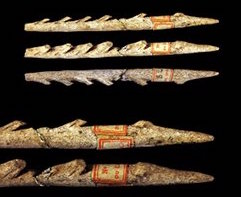
Besides stone, early humans also used bone to make things like knives, fishhooks, harpoons, and sewing needles. Of course, materials like stone and bone remain long after other types of materials have decomposed. The animal skin clothing, for instance, is long gone even though the needles used to make it can still be found. And speaking of clothes, early humans were not so busy with survival that they had to neglect fashion. They may have adorned their clothing with beads, made from soapstone through which they punched small holes (Feder & Park, 2007; “Great Human Odyssey,” 2015).
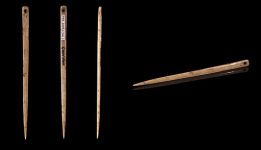
Carved Figurines
In a sense, our species simply improved upon the tool making traditions of earlier hominids. On the other hand, as far as we know, we were the first to create objects of art. Carved figurines are found in abundance in the Upper Paleolithic. Examples include items like the Löwenmensch, found in a cave in Germany. The Löwenmensch, carved from wholly mammoth ivory, is about 35,000-40,000 years old (“Lion-Man,” 2017). The “Venus of Dolní Věstonice,” (2017) depicting a nude female was found in the Czech Republic. It is the oldest known ceramic figurine at about 25,000-30,000 years old. More well-known perhaps is the “Venus of Willendorf,” (2017), discovered in Austria. Carved out of limestone, it is about 27,000-29,000 years old. In fact, many figurines resembling, in form, these Venus figurines have been discovered, so many that we could regard the artifact as an Upper Paleolithic meme. The “Venus of Brassempouy,” (2017), made of ivory and discovered in a cave in France, is one of the earliest realistic representations of a human face. It is about 25,000 years old. Notice the hairstyles on the Venuses. Don’t they suggest that hairstyling is a thoroughly ancient cultural practice? (“Great Human Odyssey,” 2015).
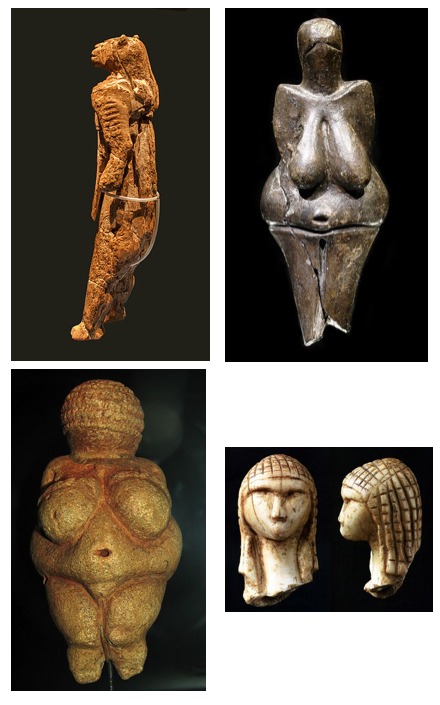
Painting
Painting too is an ancient achievement. There is evidence of it in every part of the world. Perhaps the oldest and most remarkable paintings are those that have been discovered in caves in France and Spain. Particularly awesome are the 30,000-32,000-year-old paintings discovered in the Chauvet-Pont-d’Arc Cave in France. In the interest of preserving and protecting the site, the cave is no longer open to the public, but today, tourists can visit a facsimile of the cave, where full-scale replicas of the paintings are on display. The museum faithfully reproduces the ambience of the cave its silence, darkness, temperature, humidity and acoustics (“Chauvet Cave,” 2017). The documentary Cave of Forgotten Dreams by the renowned German cinematographer, Werner Herzog, is also a great way to experience the mystery of the Chauvet Cave.
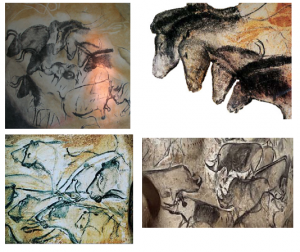
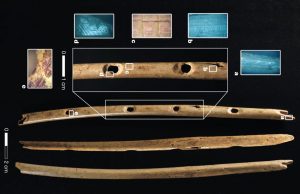
Hundreds of animals of at least 13 different species are depicted with astounding realism. The paintings have a 3-dimensional quality that suggests movement, and some animals are even depicted interacting, for example, wholly rhinoceroses butting horns. Of course, we do not know what the artists of the Upper Paleolithic thought about their painting. Was it simply an expression of aesthetic sensibility? Or was it connected with ritual and magic intent, as some interpreters have suggested? There is more to know about the material culture of the Upper Paleolithic than we can summarize here. There is evidence, for instance, that the first musical instruments may have emerged at that time. Indeed, flutes made of bone and even ivory, some as old as 40,000 years, have been discovered in caves in southern Germany (Conard, Malina & Münzel, 2009).
Although this discussion has featured the Upper Paleolithic of Europe as a center of pre-historic art, we cannot conclude that therefore the early humans of Europe were more advanced than people elsewhere on the earth. It may simply be that Europe provided an environment more conducive to the preservation of artifacts such as cave paintings. In fact, in 2014 a cave painting depicting a pig, and dated at 35,000 years old, was discovered in Indonesia, and other paintings have been discovered in Australia, depicting animals thought to have become extinct 40,000 years ago. The Australian finds though have not been definitively dated, and it is possible that scientists are wrong in their estimates of the time of extinction of the depicted animals. But it seems possible if not probable that people all over the world were painting during the Upper Paleolithic.
In conclusion, with the tool use of Paleolithic humans, we see cultural continuity with the hominids that came before us. But we see evidence of a dramatic development of culture in Homo sapiens beginning about 40,000 years ago with the rise of art and music. If culture is defined as “refinement,” it was surely in full swing in the Upper Paleolithic.
Origins of mythology
While some products of human activity can be classified as material culture, other products are non-material. Stone tools, for instance, that remain long after their creators are gone, are obviously material. Music, on the other hand, is ephemeral. We suppose, quite reasonably, that flute music drifted through the valleys of Ice Age Europe only because we have found flutes, and where there were flutes (a material product), there must have been music (a non-material product). Was there also spoken language? There is certainly no good reason to doubt it. Then how about stories? Music and stories would be examples of cultural products that are non-material.
If anything, storytelling may be more ancient than painting, sculpting, and music. Even more surprising is that just as all humans may have come from an original population of Africans, there may have also been a single African source for all of our collective creation myths. Creation myths are stories that seem intended to answer our deepest human curiosities. On the surface, at least, these myths seem to answer questions such as:
- Where did this world in which we find ourselves come from?
- How did it arise?
- How did we humans come to be here?
- What will become of us?
In this section, we’ll summarize a remarkable piece of scholarship by Michael Witzel (2012) on the origins of the world’s mythologies. Witzel’s work was inspired, in part, by the Recent African Origin hypothesis. In brief, Witzel claims that when humans left Africa, they did so telling a particular story about the origins of the world, (today we would call it the universe). The story told of the beginnings of the earth and everything in it, as well as the sky above. It included a recounting of the appearance of generations of humans, and it ended with a final destruction.
But before we examine Witzel’s ideas about the origin of world mythology, let’s sample some of the creation stories of various peoples around the world.
Stories of creation – A sampling
In the beginning, neither heaven nor earth had names. Apsu, the god of fresh waters, and Tiamat, the goddess of the salt oceans, and Mummu, the god of the mist that rises from both of them, were still mingled as one. There were no mountains, there was no pastureland, and not even a reed-marsh could be found to break the surface of the waters.
It was then that Apsu and Tiamat parented two gods, and then two more who outgrew the first pair. These further parented gods, until Ea, who was the god of rivers and was Tiamat and Apsu’s great-grandson, was born. Ea was the cleverest of the gods, and with his magic Ea became the most powerful of the gods, ruling even his forebears.
Apsu and Tiamat’s descendants became an unruly crowd. Eventually Apsu, in his frustration and inability to sleep with the clamor, went to Tiamat, and he proposed to her that he slay their noisy offspring. Tiamat was furious at his suggestion to kill their clan, but after leaving her Apsu resolved to proceed with his murderous plan. When the young gods heard of his plot against them, they were silent and fearful, but soon Ea was hatching a scheme. He cast a spell on Apsu, pulled Apsu’s crown from his head, and slew him. Ea then built his palace on Apsu’s waters, and it was there that, with the goddess Damkina, he fathered Marduk, the four-eared, four-eyed giant who was god of the rains and storms.
Enuma Elish – Babylonia, 1100 BCE in writing; possibly existed from c. 1800 BCE, (Creation Stories from Around the World)
* * *
There was neither “being” [sat] nor “nonbeing” [asat] then, nor intermediate space, nor heaven beyond it. What turned around? Where? In whose protection? Was there water? —Only a deep abyss.
There was neither death nor immortality then, nor was there a mark of day and night. It breathed, windless, by its own determination, this One. Beyond this there was nothing at all. Darkness was hidden by darkness, in the beginning.
A featureless salty ocean was all this (universe). A germ, covered by emptiness, was born through the power of heat as the One. Desire arose then in this (One), in the beginning, which was the first seed of mind. In “nonbeing” the seers found the umbilical cord [relationship] of being, searching (for it) in their hearts with planning. Obliquely stretched out was their cord.
Was there really “below”? Was there really “above”? There were the ones bestowing seed, there were “greatnesses” [pregnancies]. Below were their own determinations, above was granting.
Who then knows well, who will proclaim here, from where they have been born, from where (came) this wide emanation? Later than its emanation are the gods. Who then knows from where it developed?
From where this emanation developed, whether it has been created or not—if there is an “overseer” of this (world) in the highest heaven, he alone knows it—or (what) if he does not know?
Rig Veda – India, c. 1000 BCE, (Witzel, 2012: 107)
* * *
Verily, at first Chaos [void] came to be, but next wide-bosomed Earth, the ever sure foundation of all … and Eros (Love), fairest among the deathless gods… From Chaos came forth Erebus [darkness] and black Night; but of Night were born Aether and Day, who she conceived and bore in union with love from Erebus. And Earth first bore starry heaven, equal to herself, to cover her on every side.
Theogony – Greece, c. 700 BCE, (Witzel, 2012: 108)
* * *
In the beginning the Elohim made the sky and the earth, but the earth was shapeless and everything was dark. The Elohim said “Let there be light,” and there was the light that made day different from night. And that was the first day.
The Elohim said, “Let there be a dome to separate the heavens from the waters below,” and there were the heavens. And that was the second day.The Elohim said, “Let the waters of the earth gather so that there are seas and there is dry land,” and so it was. The Elohim said, “Let there be vegetation on the land, with plants to yield seeds and fruits,” and so it was. And that was the third day.
The Elohim said, “Let there be light in the heavens, and let them change with the seasons,” and so there were stars. Then the Elohim made a sun and a moon to rule over the day and to rule over the night. And that was the fourth day.
The Elohim said, “Let there be creatures in the waters, and let there be birds in the skies,” and so there were sea monsters and sea creatures and birds. The Elohim blessed them, saying “Be fruitful and multiply”. And that was the fifth day.
The Elohim said, “Let the earth have animals of various kinds”, and so it was. Then the Elohim said, “Let us make humans after our own likeness, and let them rule over the fish of the sea, over the birds of the air, over the cattle and creeping things of the land, and over all the earth.” The Elohim said to these humans, “Be fruitful and multiply, and fill the earth and subdue it, ruling over the fish and the birds and the animals of the land. We have given you every plant and tree yielding seed. To every beast and bird of the Earth we have given every green plant for food.” And that was the sixth day.
And on the seventh day the making of the heavens and earth was finished, and the Elohim rested.
The Elohim – Hebrew, c. 600 BCE, (Creation Stories from Around the World)
* * *
In a time when Heaven and Earth still were without form, was called the great beginning. The tao began in the great emptiness… Then “breaths” were born from space and time. What was light moved and formed the sky (easily); what was heavy, the earth … this process was difficult.
Huainan zi – China, c. 150 BCE, (Witzel, 2012: 107)
* * *
Once there was the age when Ymir lived.
There was neither sand, nor sea, nor salty waves,
Not was Earth found, not Upper Heaven,
A yawning gap [abyss], and grass nowhere.
Edda – Iceland, c. 1177 CE, (Witzel, 2012: 109)
* * *
Io dwelt within the breathing space of immensity.
The Universe was in darkness, with water everywhere.
There was no glimmer of dawn, no clearness, no light.
And he began by saying these words—
That he might cease remaining inactive:
“Darkness become a light-possessing darkness.”
And at once light appeared
…Then (he) looked to the waters which compassed him about, and spake a fourth time, saying:
“The waters of Tai-kama, be ye separate.Heaven be formed.” Then the sky became suspended.
“Bring forth thou Tupua-horo-nuku.”
And at once the moving earth lay stretched abroad.
Maori – New Zealand, compiled 1840-50s, (Witzel, 2012: 109)
* * *
The first world was Tokpela [Endless Space].
But first, they say, there was only the Creator, Taiowa. All else was endless space. There was no beginning and no end, no time, no shape, no life. Just an immeasurable void that had its beginning and end, time, shape, and life in the mind of Taiowa the Creator.
Then he, the infinite, conceived the finite. First he created Sótuknang to make it manifest, saying to him, “I have created you, the first power and instrument as a person, to carry out my plan for life in endless space… Go now and lay out these universes in proper order so they may work harmoniously with one another according to my plan.
Sótuknang did as he was commanded. From endless space, he gathered that which was to be manifest as solid substance, molded it into forms, and arranged them in nine universal kingdoms: one for Taiowa the Creator, one for himself, and seven universes for the life to come…
Hopi – Arizona, compiled in 1950s, (Waters & Fredericks, 1977)
Similarities among creation stories
Upon first reading, the stories may seem quite different. But perhaps you noticed that beyond the differences in style, and in particular details, the basic theme is the same. Each myth, for instance, begins in much the same way. The world comes into existence out of chaos, formlessness, and darkness. Or, in some cases, out of primordial sea. At first, the world comes about not by an act of creation, but as an emergence, an emanation.
Some accounts are more abstract and philosophical. The passage from the Rig Veda, for instance, begins in philosophical abstraction making the distinction between “being” [sat] and “nonbeing” [asat]. Moreover, it remains reflective, never quite becoming something the reader can easily visualize. (If you need to be convinced, please read it again.)
Other accounts, like the Babylonian Enuma Elish or the Greek Theogony portray the emergence of the world using more sensual, anthropomorphic images. However, the basic theme is the same. You may have noticed in many of these stories that powerful beings, such as gods, come only after the world has emanated out of the void:
- Apsu, the god of fresh waters, and Tiamat, the goddess of the salt oceans, and Mummu, the god of the mist that rises from both of them, were still mingled as one. There were no mountains, there was no pastureland, and not even a reed-marsh could be found to break the surface of the waters. It was then that Apsu and Tiamat parented two gods, and then two more who outgrew the first pair. (Enuma Elish)
- Later than its emanation are the gods. (Rig Veda)
- … at first Chaos [void] came to be, but next wide-bosomed Earth, the ever sure foundation of all … and Eros (Love), fairest among the deathless gods… From Chaos came forth Erebus [darkness] and black Night… (Theogony)
And notice how many of the narratives emphasize the emergence of mind or a primordial consciousness arising out of the void:
- Desire arose then in this (One), in the beginning, which was the first seed of mind. (Rig Veda)
Sometimes this emergence is characterized in terms of breath or breathing:
- The Tao began in the great emptiness… Then “breaths” were born from space and time. (Huainan Zi)
Breathing, or mind are sometimes characterized as co-existent with the void:
- Io dwelt within the breathing space of immensity. (Maori)
- There was no beginning and no end, no time, no shape, no life. Just an immeasurable void that had its beginning and end, time, shape, and life in the mind of Taiowa the Creator. (Hopi)
In some versions of the story, the qualities of the material world are sometimes brought into existence by an act of imagination:
- Then he, the infinite, conceived the finite. (Hopi)
In other versions, the qualities of the world are brought about by an act of speech:
- And he began by saying these words—That he might cease remaining inactive: “Darkness become a light-possessing darkness.” And at once light appeared …etc. (Maori)
- … but the earth was shapeless and everything was dark. The Elohim said “Let there be light,” and there was the light that made day different from night. (Hebrew)
Accounting for common motifs
What do we make of these worldwide similarities? Are they simply coincidental? Scholars of comparative mythology have proposed several possible theories.
1. Diffusion
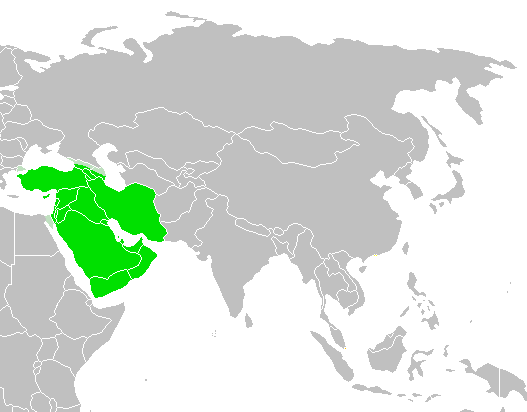
One theory is that individual motifs spread outward from an early civilization, such as Egypt or Mesopotamia to the older hunter and gatherer cultures living on the frontiers of the empire. These tribal peoples then adopted the “parent” myths and developed their own local variations of the myth based on their own local experiences.
Witzel acknowledges that some religious mythologies, e.g., Judeo-Christian-Islamic and Buddhist are known to have spread regionally in this way. However, he notes that the many myths continue according to a complex sequence of episodes. In literature, we would call this a plot. Witzel questions whether an entire myth complex could really successfully spread worldwide across such great distances to end up as far away from the early centers of civilization as South America and the Pacific Islands.
2. Myths as universal features of human psychology
Other scholars see myths as expressions of universal patterns of human thought (Campbell, 1949; Jung, 1953). According to this theory being human naturally involves universal experiences: of human relationship, of nurturance, of struggle for survival, of conflict, of passing through life stages, of death, and so on. Moreover, humans evolved as language using and concept-forming animals, and as creators of symbolic forms of expression. As a result, certain thoughts and images arise spontaneously in human imagination by virtue of our common humanity.
Supporters of this theory suggest that the motifs expressed in myths arose independently in many different places around the world because human experience, out of which the mythical imagination arises, is similar everywhere. But the myths differ in specific details because the imagery is also influenced by local geography and history. (Hmmm, a kind of Multiregional Origins hypothesis?)
Witzel agrees that humans may be biologically structured, with the kind of brain that produces similar images in people everywhere. However, he argues, it is hard to believe that the motifs would be organized everywhere into the same long, elaborately structured tales. Instead, Witzel offers a third explanation.
3. Creation myths all arose from a single (very) ancient source
Witzel has argued that an original mythology sprang up in ancestral Africa. From there, it was told and retold by our ancestors as they began their global migrations out of Africa 90,000 years ago. Ah-ha, the Recent African Origin hypothesis applied to mythology. Witzel’s argument is quite persuasive and seems to be supported by major discoveries over the last 30 years in linguistics, population genetics, and archaeology.
Based on extensive study of the themes and storylines across mythologies all over the world, Witzel has identified two classes of myths. He calls these two types Gondwana and Laurasian. Of the two, the Gondwana type appears to be older and less elaborately developed. Gondwana mythology is still found today among people in sub-Saharan Africa, and in Melanesia, Australia, and the Andamanese Islands. Laurasian mythology is found across Europe, Asia, northern and eastern Africa and the Americas. (Witzel hypthesizes an even earlier, Pan-Gaian mythology, ancestral to both the Gondwanan and Laurasian but doubts that we have the means to learn very much about it.)
Witzel thinks the Laurasian myth probably diverged from the Gondwana myth at least 40,000 years ago, originating somewhere in southwestern Asia, before spreading to northern and eastern Africa, Europe, northern and eastern Asia, and eventually throughout the Americas. If Witzel is correct, Laurasian mythology thrived long before the great early civilizations and the major religious traditions of the world. In other words, the world’s mythologies did not spread outward from the great civilizations. On the contrary, the first great civilizations (including those of Mesopotamia, Egypt, India and China) adopted oral traditions that were already tens of thousands of years old by the time these early civilizations arose. Today we engage with Laurasian mythology when we study the literature of classical civilizations. And many of the motifs are still discernable in the great religious traditions of today, in Hinduism, Buddhism, Judaism, Christianity, and Islam.
The Laurasian “Novel”
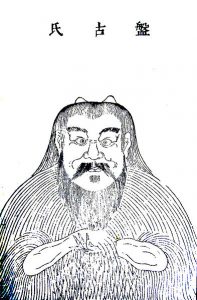
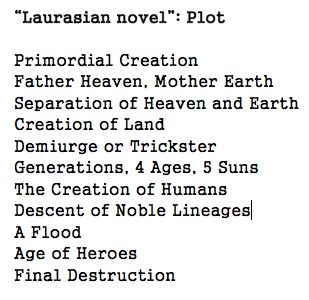
Witzel characterizes Laurasian mythology as a sort of first novel. By this he means that the creation myths found among people everywhere in the world all seem to be variations on one basic plot as shown in the sidebar. Although particular elements may be minimized or missing in some myths, or more elaborately developed in others, the basic storylines are remarkably similar. The Laurasian novel begins with the primordial creation, the earth emerging finally out of chaos, darkness, or water. In versions where the earth emerges out of water, an “earth diver” pulls the earth up out of the sea. In some versions, the earth comes out of a great, cosmic egg (for example Pangu in Chinese mythology).
In some versions, the earth is formed when a giant who existed before the world emerged is killed and carved into pieces and whose body parts become the heavens and earth (Pangu again, or Ymir in Norse mythology, and Kronos in Greek mythology). In many creation myths, the earth is closely associated with the idea of a Great Mother and in many myths is personified by woman. At the same time, the sky makes an appearance as the counterpart of the earth, and the idea, the image, of a Sky Father is born. Interestingly, in the Egyptian relief from the Book of the Dead of Nesitqnebtashru (below), the usual arrangement is reversed. The sky is the goddess, Nut (held up by the air god, Shu, and two ram-headed deities). The Earth God, Geb, reclines beneath. Originally, however, Nut was regarded as goddess of the nighttime sky, so this may depict the situation at night, when the daytime sky is overshadowed by the darkness of earth (Campbell, 1988, cited in Witzel, 2012: 380).
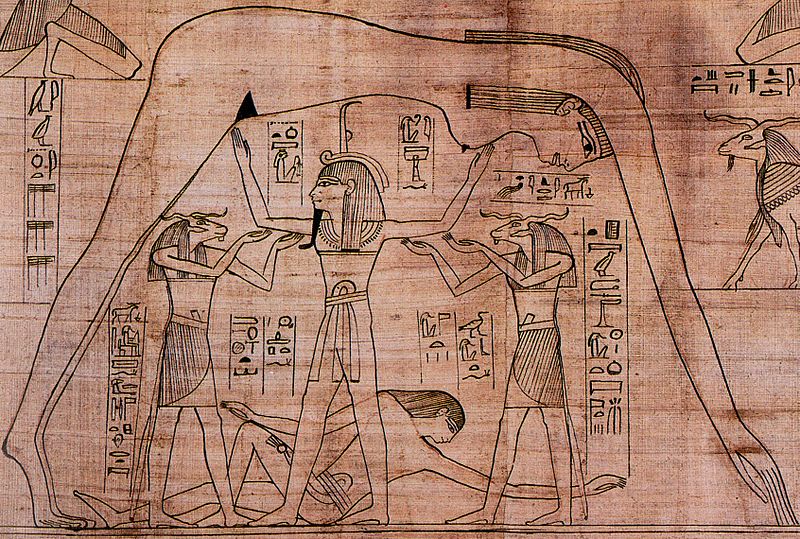
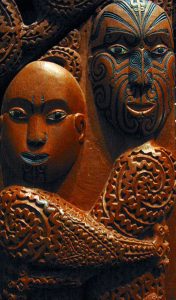
But first in the imagination of some early storytellers, the father is laying with the mother in sexual union and they must be pulled apart. The sky is pushed into place sometimes by the children, the offspring of the original parents. The theme is illustrated (right) in a Maori carving depicting the primal couple, the earth mother—Papa, and the sky father—Rangui, locked together in a tight embrace.
Sometimes the sky is propped into place by a world tree, or a stone pillar, or a world mountain. The cosmos is beginning to take the shape that we know. Now there is an earth and sky, but it is often a watery earth, and so the early storytellers must make provisions for the creation of dry land.
In many myths, there is a demiurge, a being who must form the whole of the material world, who must prepare the world for habitation. The demiurge may come out of the mind of a Supreme Being and be sent to build the world and put into it all of the things, animate and inanimate. The demiurge brings light to the world and sets the sun in place. Once there is a sun and an alternation of day and night, the earth is ready to support life. The earth then receives moisture (water); in some traditions, there is the slaying of a dragon and the earth is fertilized in its blood.
The demiurge, sometimes known too as a trickster, not only prepares the world but brings human life into it as well. The trickster also brings culturally important elements to humans such as “fire” and “the heavenly drink,” (i.e., alcoholic drink). But the creation of humans and many of these cultural developments do not emerge until later in the story, so as with any good novel, we can leave the trickster, lurking in the background as we turn to the next important chapter in our Laurasian novel.
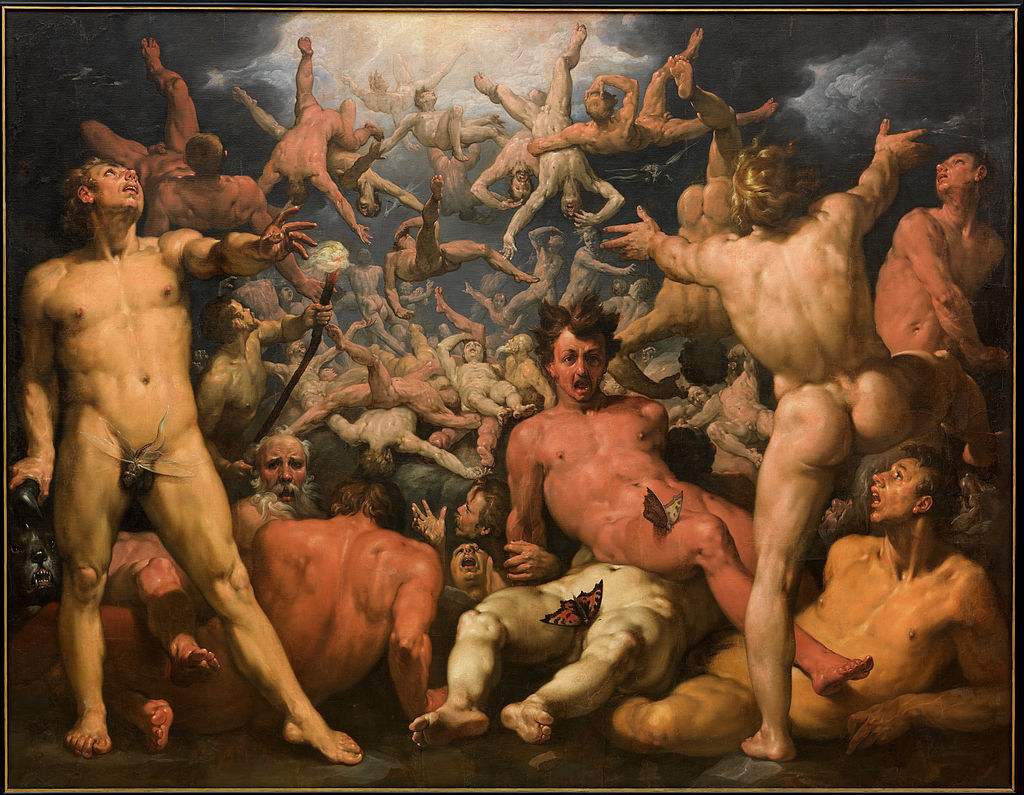
Back to the two original gods, Earth and Sky. Earth and Sky produce children. These are the first gods and goddesses, and the story progresses through an epic spanning four or five generations of gods/goddesses and their exploits. These are tales of conflict and treachery among the gods but in the process the lands of the earth are laid out and the earth is peopled. In some versions of the story an original giant, sometimes one of the primordial gods is cut into pieces, and scattered to form the dry land. Themes of incest among the various gods or deities and continuing competition and conflict dominate many versions of the Laurasian novel. There is often warfare between two groups of gods who sometimes agree to share power; sometimes, defeated gods leave the inhabited center of the world. In Greek mythology, for example, the younger generation of gods, the Olympians, go to war with the older generation, the Titans, to see who will reign over the universe.
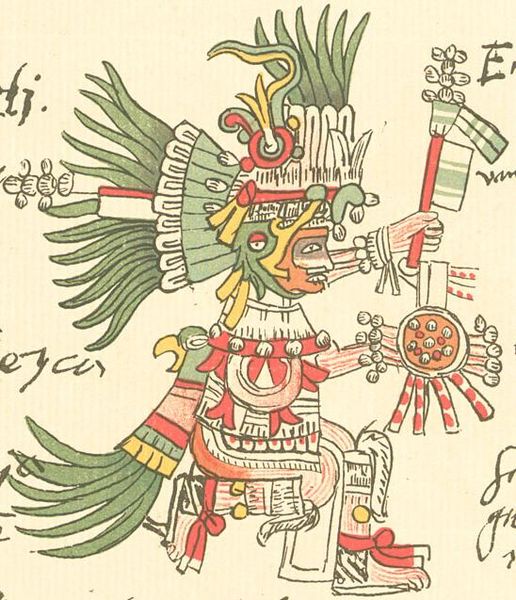
After several generations of gods, human beings make their appearance and the plot follows the succession of noble lineages of humans. The first humans are semidivine. Across the globe, from Egypt and Mesopotamia and on to India, China, Japan, and Polynesia, and into the Americas, there are stories of noble lineages; often the characters in these lineages trace their ancestry to a sun deity. A common feature of these stories is that after one or two generations, the descendants of the sun deity lose their immortality; i.e., humans become mortal.
In some myths, there is a competing storyline though. Many creation stories involve the creation of humans from clay. In other stories humans come from trees, maize, an egg, or a gourd. However, according to Witzel, this particular storyline is more representative of Gondwana mythology. Witzel surmises that Laurasian mythology is intimately tied to shamanism—a male vocation—and that when older Gondwana motifs find their way into the Laurasia storyline, it may be because of the co-existence in various cultures of “grandmothers tales,” motifs kept alive through stories told by women.
A dramatic chapter in the story of humans comes after humans have lived for many generations on the earth. Somehow humans displease or anger a powerful being who destroys most of humankind in a great flood. The Laurasian saga then continues with the reemergence of humans and there are many overlapping tales of heroes. Some heroes are semidivine, and their exploits coincide with those of the gods. Sometimes, there is an age of heroes after the gods.
Finally, the Laurasian novel ends in a final destruction of the world. Even the gods are destroyed. The Ragnarök in Norse mythology is one of the most detailed stories of the final destruction. Odin and Thor and all the major gods and their adversaries, Fenrir, the wolf and the giant poisonous serpent, Jörmungandr are all destroyed. The sun turns black, the earth sinks into the sea, the stars vanish, steam rises, and flames touch the heavens. After the destruction, the world resurfaces new and fertile. Some surviving gods return and the world will be populated anew by two human survivors. The final destruction is thus paired with the hope for a new, more perfect world. In many myths, the world is created anew and there are a series of Four or Five Ages, each age ending in a final destruction.
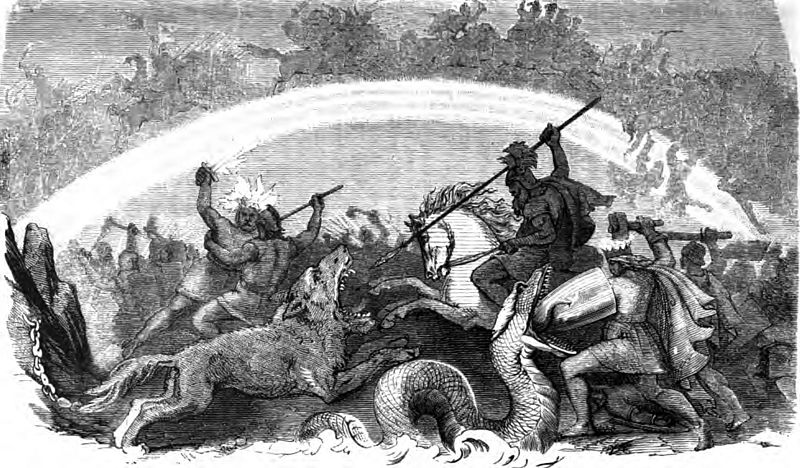
Final Reflection
What does this discussion about an apparently very old plot have to do with us today? Well if Witzel is correct, the basic storyline of creation and human origins found in both oral and literary traditions worldwide was conceived a very long time ago, and we humans have been telling various versions of this same story for over 100,000 years. Following the stories of our own traditions back to their earliest origins, we all find ourselves, perhaps, sitting in the same circle. In this chapter, we have suggested that the well-known creation myths found in the literature and oral traditions from every corner of the world are a dramatic reminder of the power of cultural transmission in shaping the human imagination.
Application
For Further Thought and Discussion
- Review the seven themes of culture from Chapter 1. Which themes do you think are reflected (either explicitly or implicitly) in this chapter? Make a case for several of the themes, i.e., explain how they are relevant to the chapter.
- Read through the myths again in the Stories of Creation section. Which, if any, were you already familiar with? Which were new? Which one do you find the most interesting? Why?
- In what way is culture different from civilization? (This question is not answered directly in the chapter. You must infer it.)
- In what way(s) has your knowledge of culture changed after reading this chapter? What did you already know? What was new? Did anything surprise you?
Video Clips & Documentaries
“Great human odyssey.” 5 Oct. 2016. Webcast. NOVA. PBS. KUED, Salt Lake City. Accessed on 24 June 2017. http://www.pbs.org/wgbh/nova/evolution/great-human-odyssey.html
Scenes from ‘Cave of Forgotten Dreams.’ YouTube. https://www.youtube.com/watch?v=_xDcdVWnOiE
“Stone Tool Technology of Our Human Ancestors.” 27 March 2015. HHMI BioInteractive Video. YouTube. Accessed on 24 June 2017. https://www.youtube.com/watch?v=L87Wdt044b0
“The Minds of Stone Age Tool Makers.” 3 Nov. 2010. YouTube. Accessed on 24 June 2017. https://www.youtube.com/watch?v=vmanlBDFfw0
References
Barham, L. (2013). From hand to handle: The first industrial revolution. Oxford, UK: Oxford.
Brown, M. H. (1990). The search for Eve. New York: Harper & Row.
Campbell, J. (1968). The hero with a thousand faces, (2nd ed.). Princeton, NJ: Princeton.
Campbell, J. (1988). Historical atlas of world mythology, (vol 1). New York: Harper & Row.
“Chauvet Cave.” (2017, May 18). In Wikipedia, The Free Encyclopedia. Retrieved June 25, 2017 from https://en.wikipedia.org/w/index.php?title=Chauvet_Cave&oldid=780942868
Conard, N. J., Malina, M. & Münzel, S. C. (2009). New flutes document the earliest musical tradition in southwestern Germany. Nature 460, 737-740. https://www.nature.com/articles/nature08169
Creation stories from around the world. Retrieved June 25, 2017 from http://railsback.org/CS/CSIndex.html
Feder, K. L. & Park, M. A. (2007). Human antiquity: An introduction to physical anthropology and archaeology, (5th ed.). Boston: McGraw-Hill.
“Great human odyssey.” 5 Oct. 2016. Webcast. NOVA. PBS. KUED, Salt Lake City. Accessed on 24 June 2017. http://www.pbs.org/wgbh/nova/evolution/great-human-odyssey.html
Herzog, W. (2010). “Cave of Forgotten Dream.” YouTube. https://www.youtube.com/watch?v=_xDcdVWnOiE
Jung, C. G. (1953). Two essays in analytical psychology. Princeton, NJ: Princeton.
“Lion-man.” (2017, June 24). In Wikipedia, The Free Encyclopedia. Retrieved June 25, 2017 from https://en.wikipedia.org/w/index.php?title=Lion-man&oldid=787303025
Mesoudi, A. (2011). Cultural evolution: How Darwinian evolution can explain human evolution and synthesize the social sciences. Chicago: University of Chicago Press.
“Stone Tool Technology of Our Human Ancestors.” 27 March 2015. HHMI BioInteractive Video. YouTube. Accessed on 24 June 2017. https://www.youtube.com/watch?v=L87Wdt044b0
“The Minds of Stone Age Tool Makers.” 3 Nov. 2010. YouTube. Accessed on 24 June 2017. https://www.youtube.com/watch?v=vmanlBDFfw0
“Venus of Brassempouy.” (2017, March 15). In Wikipedia, The Free Encyclopedia. Retrieved June 25, 2017 from https://en.wikipedia.org/w/index.php?title=Venus_of_Brassempouy&oldid=770380639
“Venus of Dolní Věstonice.” (2017, June 17). In Wikipedia, The Free Encyclopedia. Retrieved June 25, 2017 from https://en.wikipedia.org/w/index.php?title=Venus_of_Doln%C3%AD_V%C4%9Bstonice&oldid=786138534
Venus of Willendorf. (2017, May 28). In Wikipedia, The Free Encyclopedia. Retrieved June 25, 2017 from https://en.wikipedia.org/w/index.php?title=Venus_of_Willendorf&oldid=782669278
Waters, F. & Fredericks, O. W. B. (1977). Book of the Hopi. New York: Penguin.
Wilford, John N. (June 24, 2009). “Flutes Offer Clues to Stone-Age Music”. Nature. 459 (7244): 248–52. Retrieved June 25, 2017 from http://www.nature.com.dist.lib.usu.edu/articles/nature08169
Witzel, E. J. M. (2012). The origins of the world’s mythologies. New York: Oxford.
Image Attributions
Image 1: “Makavot-even” by The GNU Project is licensed under CC BY-SA 2.5; “Happisburg handaxe” by Portable Antiquities Scheme is licensed under CC BY-SA 3.0; “Burins and blades – Bernifal – Meyrals – MNP” by Sémhur is licensed under CC BY-SA 4.0; “Blombos point” by Vincent Mourre is licensed under CC BY-SA 3.0;
Image 2: “Hafted stone pick” by Mark Marathon is licensed under CC BY-SA 4.0
Image 3: “Magdalenian” by Rama is licensed under CC BY-SA 2.0 FR
Image 4: “Aiguille” by Didier Descouens is licensed under CC BY-SA 4.0
Image 5: “Loewenmensch2” by Thilo Parg is licensed under CC BY-SA 3.0; “Vestonicka venuse edit” by Petr Novák, Wikipedia and is licensed under CC BY-SA 2.5; “Willendorf-Venus-1468” by Don Hitchcock is licensed under CC BY-SA 3.0; “Venus of Brassempouy” by Jean-Giles Berizzi is licensed under Public Domain 1.0
Image 6: “Paintings from Chauvet Cave” is licensed under Public Domain-1923; “Rhinos” is licensed under Public Domain-1923;“Chauvethorses” is licensed under Public Domain-1923; “Lions” is licensed under Public Domain-1923
Image 7: “Bone flute from Hohle Fels archaeological horizon Vb” is licensed under Nature Research
Image 8: “Southwest-Asia-map” by Vervictorio is licensed under Public Domain 1.0
Image 9: “Laurasian Novel” by Nolan Weil is licensed under CC BY 4.0
Image 10: “Pangu” by Wang Qui is licensed under Public Domain-1923
Image 11: “Geb, Net, Shu” photographed by the British Museum is licensed under Public Domain-1923
Image 12: “WahineTane” by Kahuroa is licensed under Public Domain 1.0
Image 13: “Cornelis Cornelisz. Van Haarlem – The Fall of the Titans” by Cornelis Van haarlem is licensed under Public Domain 1.0
Image 14: “Huitzilopochtli telleriano” is licensed under Public Domain-US
Image 15: “Kampf der untergehenden Götter” by F.W. Heine is licensed under Public Domain 1.0

